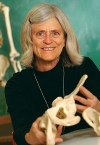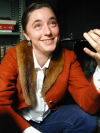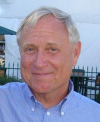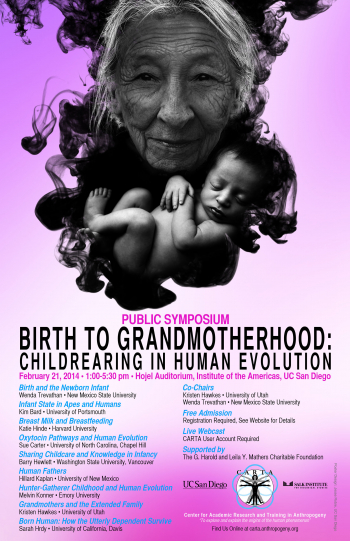Birth to Grandmotherhood: Childrearing in Human Evolution
Kristen Hawkes, University of Utah
Wenda Trevathan, School for Advanced Research, Santa Fe, New Mexico
The goal is to take a broad view of the importance of child-rearing in human evolution, from birth to the impact of grandmothers. From the moment of birth, human infants require an inordinate amount of care and, unlike our nearest living relatives, remain dependent on a variety of caretakers during an unusually long maturation period followed by extraordinary adult longevity. How did such a distinctive pattern of development evolve and what other human features are linked to it? In this symposium, we will take a comparative perspective and consider neuroendocrine factors, energetics, life-history trade-offs and consequences for culture.
Media for each talk can be played by clicking on icons in the table below, or by clicking on the individual talk titles below and then the attachment file at the bottom of the page.
| Speakers | Media | Session |
|---|---|---|
 Margaret Schoeninger |
|
Welcome and Opening Remarks |
 Wenda Trevathan |
|
Birth and the Newborn Infant The high degree of dependency at birth and an inordinately slow rate of growth of human infants and children place demands on mothers and other caretakers that appear to far exceed those of other mammals, including our closest primate relatives. What role do gestation and birth play in producing these highly dependent and slow growing infants that require investment from a variety of caretakers and numerous life history trade-offs? This presentation will focus on energetic and biomechanical... read more |
 Kim Bard |
|
Infant State in Apes and Humans What are the inborn capacities of chimpanzees? How do chimpanzees compare to humans? These questions typify the long-standing interest in "what makes us human." As a developmental psychologist, I am interested in describing the developmental process, and as a comparative psychologist, I am interested in comparing development in chimpanzees with development in humans. In this talk, I will present data on comparative development of infant states, that is, states of arousal, state regulation,... read more |
 Katie Hinde |
|
Breast Milk and Breastfeeding Milk is abundant at our local grocery store in the form of dairy products and infant formulas. This ubiquity of homogenized milk in our modern environment has the potential for the general public, and even researchers, to think of milk unidimensionally. Milk is not just food, however, but is also medicine and signal. Hundreds, possibly thousands, of other milk “bioactives” provide immunity and physiological regulation for the infant. Importantly, milk is not uniform across mothers or within an... read more |
 Sue Carter |
|
Oxytocin Pathways and Human Evolution This presentation examines the hypothesis that Homo sapiens, with their high level of dependence on social behavior and cognition, could not have evolved without the neuropeptide, oxytocin. Oxytocin pathways - which include oxytocin, the related peptide vasopressin, and their receptors - are at the center of physiological and genetic systems that permitted the evolution of the human nervous system and allowed the expression of contemporary human sociality. Unique actions of oxytocin pathways,... read more |
 Barry Hewlett |
|
Sharing Childcare and Knowledge in Infancy Giving and sharing are central to understanding humanity and human evolution. The talk examines reproductive (i.e., allomaternal care) and information (i.e., knowledge and skills) sharing among Aka hunter-gatherers of the Congo Basin. Particular attention is given to understanding the contexts of allomaternal nursing and teaching during infancy. |
 Hillard Kaplan |
|
Human Fathers In this talk, I will present a theoretical model linking ecology to male paternal investment. The basic argument is that there are three fundamental potential inputs into offspring fitness: genes, care and energy. The ecological niche to which the population/species is adapted determines three important relationships: 1) the impacts of variation in each of those inputs on offspring fitness; 2) the degree to which those inputs are complements or substitutes; and 3) the extent to which... read more |
 Melvin Konner |
|
Hunter-Gatherer Childhood and Human Evolution Even compared to other primates, we humans develop slowly, with high levels of parental and non-parental care. Research on infancy and childhood among !Kung (Bushman) hunter-gatherers of northwestern Botswana, the first hunting-gathering group where childhood was quantitatively studied, yielded a distinctive characterization of their patterns of child care and behavioral development, and surveys of prior ethnographic literature suggested that core features of these patterns were seen in other... read more |
 Kristen Hawkes |
|
Grandmothers and the Extended Family Conjugal families are often assumed to be building blocks of human societies and the primary site of childrearing in traditional communities. Alternatively, the Grandmother Hypothesis draws attention to other relationships likely fundamental in the evolution of our lineage. Persistent ties that crosscut conjugal families are implied by our cooperative childcare, distinctive prosociality, and extraordinary operational sex ratios. Sarah Hrdy has highlighted the universality of human cooperative... read more |
 Sarah Hrdy |
|
Born Human: How The Utterly Dependent Survive Hominin infants who needed to elicit care and provisioning from allomothers as well as mothers confronted a different set of challenges from those faced by their last common ancestor with other apes. Reliance on allomaternal assistance to rear young rendered mothers increasingly sensitive to signals of how much social support she and her offspring could expect, and multiple offspring with overlapping periods of dependency meant mothers might be forced to choose between offspring when investing... read more |
 Speaker TBD |
|
Wrap-Up, Question and Answer, and Closing Remarks |
| Attachment | Size |
|---|---|
| 1.72 MB | |
| 1.69 MB | |
| 1.75 MB | |
| 417.55 KB | |
| 798.73 KB | |
| 322.83 KB |
If you enjoy this event, please consider supporting CARTA's quest to explore and explain the human phenomenon.


